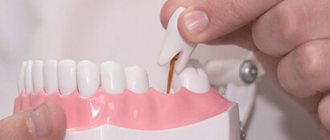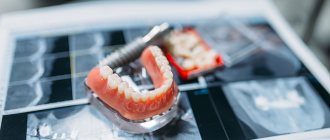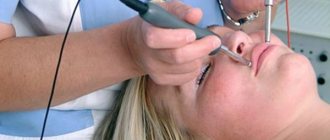We are all afraid of going to the dentist, sometimes it even seems that this fear nests somewhere at the genetic level. But it is impossible to avoid regular visits to the dentist, especially considering that dental diseases directly affect the development of other, much more dangerous diseases.
Dental technology has already changed significantly almost everywhere, and the future, which is almost around the corner, promises us even greater changes in this area of healthcare. Imagine that you receive dentures literally an hour after visiting the dentist, and not after 4 - 5 visits to him? Can you imagine a telemedicine visit to the dentist? What do you think about the possibility of growing new teeth at the age of 80?
Here we would like to briefly introduce you to the 8 main innovations in dentistry.
Smart toothbrush
You won’t surprise us with “smart” electronic devices, and now these electronics have reached the bathroom. The Kolibree “smart” electronic toothbrush, together with the corresponding application, allows you to remain confident that you are brushing your teeth correctly, and also offers children fun games that teach them to brush their teeth correctly and regularly.
Philips also released its own brush that works via Bluetooth, including it in its already fairly large line of smart consumer medical devices. It uses a set of sensors to track how you brush your teeth in real time. And it does it extremely simply and clearly. The app shows a 3D map of the user's teeth, showing the teeth they are currently brushing and telling them if they have been brushing too little or too long. It also warns of too much pressure or a harsh cleaning style.
Quattro Ti - innovative prostheses without palate
If the client does not have a large number of units, previously he could only be offered a bulky removable structure that covered both the gums and a significant area of the palate. This caused serious discomfort.
Scientists have developed more advanced systems - Quattro Ti. They belong to the clasp category, but do not require the use of a metal frame. The absence of a massive chafing palate and a soft plastic base make the Quattro Ti comfortable to wear. What is important is that they are securely held in the human mouth - falling out or moving during laughter, coughing, screaming, or sneezing is excluded.
An interesting fact is that flavors can be used in the production of Quattro Ti . Then the future owner receives a device with the chosen flavor - fruit, vanilla or chocolate. This is a significant advantage for those people who cannot stand the taste of plastic in their mouth.
Augmented Reality
The University of Strasbourg in France is using augmented reality for coursework and practical work to demonstrate dental models to students and allow students to compare the prosthetics they create with reference models. Faculty at this university believe that in just a few years, augmented reality technology will completely revolutionize dental education.
A similar device, called the DentSim Simulator, was developed by Image Navigation - it uses augmented reality technology for simulation, allowing students from all over the world to hone their skills. This training system has already been used by 10 thousand dentists from 17 countries.
Piercing
About 20 years ago, piercing was at its peak in popularity. Then the fashion for such jewelry went away. Current trends indicate the popularity of earrings on the body among young people. Piercing today is not only a piercing of the nose, navel or eyebrow, it is also a piercing of the tongue or lip. A small earring or more eccentric jewelry can be inserted into the piercing. A dental surgeon installs the piercing. If the puncture is performed correctly and the jewelry is selected, there are no consequences from the piercing in the form of suppuration, scars or large holes.
A virtual reality
Just like augmented reality technology, virtual reality (VR) can be used for training and professional development of dentists. Today, only a couple of students can peek over the surgeon's shoulder as he performs a complex operation, and this significantly complicates the learning process. But a VR camera allows you to broadcast an operation around the world and do it literally “through the eyes of a surgeon” if students use VR glasses. For example, this summer, Nobel Biocare already organized a broadcast of a dental operation, which was available through virtual reality devices.
Virtual reality technology is also useful for patients - recent experiments have shown that VR broadcasts of natural, relaxing scenes work great as a pain reliever for people in the dentist's chair, while leaving a pleasant aftertaste.
Teledentistry
Many people find it difficult to visit the dentist due to distance, illness, disability or old age. Telemedicine in dentistry is designed to solve this problem by providing easier and cheaper access to treatment. At the same time, it is intended to shift the emphasis from advanced treatment to preventive procedures, allowing patients to consult with a specialist more often and take the necessary measures in a timely manner. In the United States, this service has already begun to spread widely. For example, MouthWatch launched a fully integrated turnkey telemedicine system for dentists called MouthWatch TeleDent. This system is a platform for dentists or hygienists to provide visual consultations to patients in remote locations and evaluate their oral health in real time (or at other times at the patient's request) using a regular web browser.
Zirconium dioxide implants
Implants made from zirconium dioxide successfully replace metal structures. In addition, zirconium implants are implanted into bone tissue much faster than titanium ones. Zirconium dioxide is highly resistant to mechanical loads, both static and dynamic. It is quite easy to process and integrate into the jaw bones.
The advantages of the material include:
- high strength;
- long service life;
- no allergic reaction in patients.
Zirconium dioxide, unlike titanium alloys, does not release metal microparticles into the soft tissues of the oral cavity.
Computer aided design and 3D printing
Computer modeling and manufacturing technologies using 3D printing are beginning to revolutionize dental laboratories. They are being transformed into significantly cheaper and more efficient digital laboratories.
With the help of new technologies, the manufacturing process, for example, of crowns, is significantly accelerated. The tooth is prepared for installation of the prosthesis, then a picture of it is taken, which is sent to the computer, which controls the machine, which produces a crown suitable for this particular patient right in the office and very quickly.
By using 3D printing, all intermediate stages that create a queue are eliminated, and the doctor’s work is significantly simplified. Such solutions for dentists are already offered by Stratasys, Envisiontech and FormLabs.
CAD/CAM - a new word in computer modeling
With the advent of innovative technologies, doctors have a unique opportunity to create devices that are ideal for the oral cavity of a particular patient. Computer CAD/CAM techniques eliminate any medical errors.
Cad/Cam installations make computer visualization possible. With their help, virtual models of future incisors, canines and molars are created, which are subsequently turned on a milling machine. Of course, this innovation belongs to the expensive class, and it cannot be found in every dental laboratory. But the results obtained with its help exceed all expectations.
The operation of the Kad/Kam systems includes only 3 sequential stages:
- Taking impressions of the dentition or scanning the oral cavity with a miniature sensor.
- Creating a model of the future product on the screen based on previously made casts or photographs.
- Turning products on a machine.
When using CAD/CAM equipment, the role of humans in the production process is reduced to a minimum. The smart machine itself determines what shape to give to the workpiece and at what angle to grind its edges, so that the patient does not experience discomfort after the end of dental treatment.
Computer technologies are suitable for processing even the most reliable and durable materials - zirconium/aluminum oxide and dioxide. They can also be used to produce artificial units from pressed ceramics.
Bridges, crowns, veneers and lumineers , which were born thanks to Kad/Kam installations, are ideally suited to the person for whom they were created. They are characterized by incredibly precise positioning, fit as tightly as possible to the walls of the base and do not cause any unpleasant sensations. They serve for about twenty years.
Intraoral camera
One of the biggest inconveniences that we encounter in the dentist's chair is the inability to open our mouth even wider, which does not allow the doctor to clearly see what he needs to see, even with the help of his dental mirror. An intraoral camera solves this problem.
Various types of such devices are already offered by MouthWatch, Dürrdental and Carestream Dental. Recent developments in this area make it possible to create revolutionary devices with unique “liquid” lenses that work like the human eye, allowing you to easily obtain a clear, detailed image of all corners of the patient’s mouth.
Implants with tapered abutment connection
Such structures are non-demountable. Their conical abutment ensures uniform load over the entire area of the implant, which dramatically reduces the likelihood of root loosening while chewing solid food. Such implants can be installed below the level of the cortical bone, in the area of which there is very little blood circulation.
The advantages of this technology are:
- monolithic design;
- uniform load distribution over the entire area of the implant;
- impossibility of penetration of pathogenic microorganisms to bone tissues:
- fast and very tight implantation of the implant into bone tissue;
- the technology does not interfere with normal blood circulation in the oral cavity;
- natural appearance;
- long service life.
Tooth regeneration
One of the most interesting and promising areas in dentistry is dental regeneration and caries prevention. Bioactive dentin replacement* allows dentists to completely rethink the way they treat teeth.
Regenerative medicine today relies heavily on research into the use of stem cells and, in particular, research is currently underway to find the source of mesenchymal stem cells that have the ability to form teeth.
In April of this year, scientists from Harvard and Nottingham Universities have already developed a dental filler that allows teeth to heal on their own. This substance works by using stem cells to stimulate dentin growth, allowing the patient to regrow diseased teeth. Imagine that you were able to get rid of your artificial teeth, which will replace your own in old age.
Black smile
For more than 1000 years, there has been a fashion for the “black smile” in Japan. This tradition has a female prerogative. Japanese noble ladies and geishas celebrated their greatness in society in this way. To make their teeth black, they used varnish, which was made with the addition of iron filings and vinegar. In modern society, this trend is gaining more and more popularity. Today, of course, such aggressive methods are not used for blackening. You can make your smile black even in dental clinics that offer the application of special compounds that darken tooth enamel.
CRISPR
CRISPR is the latest method of genome editing, which nature itself provides us with and which scientists have only now learned to use. Already today, research is being conducted into the possibility of using this method to combat cancer and other serious diseases; it can also be used in dentistry.
Researchers believe that dental specialists will soon be able to identify genes associated with many oral pathologies. And when this becomes known, it will be possible to find a CRISPR solution that will allow you to properly edit the structure of the defective gene and get rid of dental problems in early childhood.
* Dentin is the hard tissue of the tooth, making up its main part.
Materials used: The Verge, Medical Futurists, VRScout, The Guardian, WebMD, Dental Products Report, Nature
Modern orthopedic dentistry: tasks and goals
Dental tissue does not regenerate and in case of loss of dental units, a person is forced to resort to prosthetics. The main task of an orthopedic dentist is to offer the patient the most correct and advanced methods for restoring the dentition. The doctor also deals with:
- Treatment of injuries, acquired or congenital anomalies of the masticatory apparatus.
- Restoring the aesthetics and functionality of the dental system in case of complete or partial loss of teeth.
- Prevention of oral diseases such as periodontitis, periodontitis, pulpitis and others.
An orthopedic dentist will help correct your bite, cope with crowded teeth, and give the necessary recommendations for maintaining oral hygiene after implantation or in case of wearing orthopedic structures (braces, removable dentures). His tasks include not only restoring the functionality and beauty of the dentition, but also choosing a gentle treatment method - painless, safe, and not harmful to bone tissue.
For this purpose, orthopedic dentistry has an arsenal of modern techniques, among which are: microprosthetics, the creation of removable dentures, and the installation of fixed structures.
Preventing caries
We have already made sufficient progress in cataloging the genomes of humans, animals and microbes. To date, the genomes of hundreds of species of bacteria have been sequenced that live in biofilms on tooth surfaces, in dental bacterial plaques and on implant surfaces. Our existing human and microbial genome databases provide new opportunities for effective drug therapy.
For example, Streptococcus mutans is one of the main bacteria associated with tooth decay. It plays a major role in tooth decay by converting sucrose into lactic acid. We now know that it is passed from parent to child in the first years of life.
Dental plaque under a microscope / ©stomatologclub.ru
Genetics will help find ways to prevent this transmission. In addition, we can target gene therapy to inhibit processes within the bacteria themselves that regulate acid production, a byproduct of sugar metabolism that causes tooth decay. We can even target selective killing of Streptococcus mutans in oral biofilms.
Robotics
Surgical robots are already taking their place in operating rooms. Soon they will become full-fledged owners of dental offices. In 2017, in a clinic in the Chinese city of Xi'an, a robot dentist successfully performed dental surgery on a living person for the first time. Under supervision, but independently and without the participation of medical staff, he installed two artificial teeth for the patient. Moreover, both implants were printed on a 3D printer.
The developers believe that the use of robots will solve the problem of the shortage of qualified dentists in the country. About a million implants are installed in China every year, but surgical errors mean many patients have to return to the doctor. In addition, the use of robots will make dental procedures less invasive and help reduce healing time.










